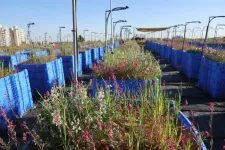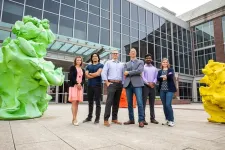(Press-News.org)
Researchers at Lund University, together with colleagues at the NIST Synchrotron Facility in the USA, have mapped on an atomic level what happens in a virus particle when the temperature is raised.
"When the temperature rises, the virus's genetic material changes its form and density, becoming more fluid-like, which leads to its rapid injection into the cell," says Alex Evilevitch a researcher at Lund University who led the study.
Viruses lack their own metabolism and the ability to replicate independently; they are entirely dependent on a host cell to multiply. Instead, the virus hijacks the internal machinery of the infected cell to produce new virus particles, which are then released and spread to infect other cells.
In most cases, the virus's genetic material, DNA, is enclosed within a protective protein shell called a capsid. A research group at Lund University is working to understand the process by which the virus ejects its genetic material from the capsid and into cells and what causes the virus's DNA to be released. It all began with a study published in 2014, where the Lund University researchers observed that there seems to be a sudden change in the virus's genetic material when exposed to the infection temperature, around 37 degrees.
"The more we raised the temperature, the stiffer the virus's DNA became. And then suddenly, at the infection temperature, something happened. It was as if there was no DNA left in the virus particle – the stiffness disappeared," says Alex Evilevitch, a professor of cell biology at Lund University.
Can change in the surrounding temperature affect the spread of the virus's DNA? The study garnered significant attention in the research community, but detailing what occurs has been a challenge and time-consuming. As an experimental model, the researchers examined what happens when exposing phage viruses – viruses that attack bacteria – to temperature increases.
"Observing the appearance of DNA in a virus particle is not something that can be done in a snap. Their genetic material is delicate, difficult to image, and moreover, phage viruses are very small – approximately ten times smaller than a bacterial cell. However, with the help of the synchrotron research facility NIST in Maryland, USA, and thanks to a special grant from the Swedish Research Council, we were ultimately able to use neutron light to image the structure of phage virus DNA and its density inside the capsid and see how these changed at different temperatures," explained Alex Evilevitch.
In the current study, now published in PNAS, they demonstrate that the ambient temperature plays a crucial role when the capsid opens, and "DNA bursts out" and enters the cell. The cell becomes infected so that phage virus particles can divide and spread to adjacent bacterial cells.
"We have also observed that the change in the DNA structure is directly linked to how effective the virus is at infecting the host cell”, commented Alex Evilevitch.
The researchers' interest in understanding more about how the virus's capsid and DNA work is partly to comprehend how DNA and RNA can be packed into such incredibly small volumes and how it can be injected so rapidly into the cell during the infection.
"This provides us with a greater understanding of how quickly DNA can exit the virus and enter the cell and may be relevant for how one can turn a virus on and off – the fundamental principle for developing new antiviral agents. It may also have significance for how nucleic acids are packaged for gene therapy purposes," said Alex Evilevitch.
Can the study be interpreted as higher body temperature increasing the risk of infection spread?
"The results point in that direction. The structure of the virus's genetic material and its mechanical properties change already when the body temperature rises to 37 degrees. We also see that a temperature increase affects the speed of virus spread. However, we have so far demonstrated this only in cell culture in our laboratory, and future studies are needed, taking into account other factors that affect the course of infection, such as the immune response."
END
Researchers at the University of São Paulo (USP) in Brazil, partnering with Foresee Pharmaceuticals, a Taiwan and US-based biopharmaceutical company, have tested a synthetic molecule for the treatment of heart failure. The study, funded by FAPESP, was published yesterday (11/07/2023) in the European Heart Journal. The theme was also highlighted in the magazine's editorial.
Heart failure is a condition in which the heart muscle cannot pump enough blood to meet the body's needs for blood and oxygen. It causes more deaths worldwide than any other disease, in the sense that other cardiovascular disorders ...
Making decisions is hard. Even when we know what we want, our choice often leaves something else on the table. For a hungry mouse, every morsel counts. But what if the decision is more consequential than choosing between crumbs and cheese?
Stanford researchers investigated how mice resolve conflicts between basic needs in a study published in Nature on Nov. 8. They presented mice that were both hungry and thirsty with equal access to food and water and watched to see what happened next.
The behavior of the mice surprised the scientists. Some gravitated first ...
The study is based on a new database created by the researchers which combines, for the first time, datasets on distribution and datasets on lifecycles, making it possible to establish the prevalence of different lifecycles around the globe. It uses empirical tools and big data to examine theoretical paradigms about the way in which human disturbance is affecting annual plants and their global distribution. Among other things, it was found that annuals are expected to benefit more with the rise in human population density and due to climate change, which ...
Scientists have engineered a chromosome entirely from scratch that will contribute to the production of the world’s first synthetic yeast.
Researchers in the Manchester Institute of Biotechnology (MIB) at The University of Manchester have created the tRNA Neochromosome – a chromosome that is new to nature.
It forms part of a wider project (Sc2.0) that has now successfully synthesised all 16 native chromosomes in Saccharomyces cerevisiae, common baker’s yeast, and aims to combine ...
A UK-based team of Scientists, led by experts from the University of Nottingham and Imperial College London, have completed construction of a synthetic chromosome as part of a major international project to build the world’s first synthetic yeast genome.
The work, which is published in Cell Genomics, represents completion of one of the 16 chromosomes of the yeast genome by the UK team, which is part of the biggest project ever in synthetic biology; the international synthetic yeast genome collaboration.
The collaboration, known as 'Sc2.0' has been a 15-year project involving teams from around the world (UK, US, China, Singapore, UK, France and Australia), working together ...
CHAMPAIGN, Ill. — A new antifungal molecule, devised by tweaking the structure of prominent antifungal drug Amphotericin B, has the potential to harness the drug’s power against fungal infections while doing away with its toxicity, researchers at the University of Illinois Urbana-Champaign and collaborators at the University of Wisconsin-Madison report in the journal Nature.
Amphotericin B, a naturally occurring small molecule produced by bacteria, is a drug used as a last resort to treat fungal infections. While AmB excels at killing fungi, it is reserved ...
Research consortium investigators analyzed over 314,000 cells from rheumatoid arthritis tissue, defining six types of inflammation involving diverse cell types and disease pathways
Understanding the disease at single-cell level may advance targeted drug development and treatment strategies
Rheumatoid arthritis (RA) is an autoimmune disease characterized by inflammation that leads to pain, joint damage, and disability, which affects approximately 18 million people worldwide. While RA therapies targeted to specific inflammatory pathways have emerged, only some patients’ symptoms improve with treatment, emphasizing the need for multiple ...
About The Study: In this study that included 3.4 million adults, co-administration of the BNT162b2 BA.4/5 bivalent mRNA COVID-19 vaccine (Pfizer-BioNTech) and seasonal influenza vaccine was associated with generally similar effectiveness in the community setting against COVID-19–related and seasonal influenza vaccine-related outcomes compared with giving each vaccine alone and may help improve uptake of both vaccines.
Authors: Leah J. McGrath, Ph.D., of Pfizer Inc., in New York, is the corresponding author.
To ...
About The Study: Earlier onset of atrial fibrillation was associated with an elevated risk of subsequent all-cause dementia, Alzheimer disease, and vascular dementia in this study including 433,000 UK Biobank participants, highlighting the importance of monitoring cognitive function among patients with atrial fibrillation, especially those younger than 65 years at diagnosis.
Authors: Fanfan Zheng, Ph.D., of the Chinese Academy of Medical Sciences & Peking Union Medical College in Beijing, and Wuxiang Xie, Ph.D., of the Peking University First ...
Electrons move through a conducting material like commuters at the height of Manhattan rush hour. The charged particles may jostle and bump against each other, but for the most part they’re unconcerned with other electrons as they hurtle forward, each with their own energy.
But when a material’s electrons are trapped together, they can settle into the exact same energy state and start to behave as one. This collective, zombie-like state is what’s known in physics as an electronic “flat band,” and scientists predict that when electrons are in this state they can start to ...


